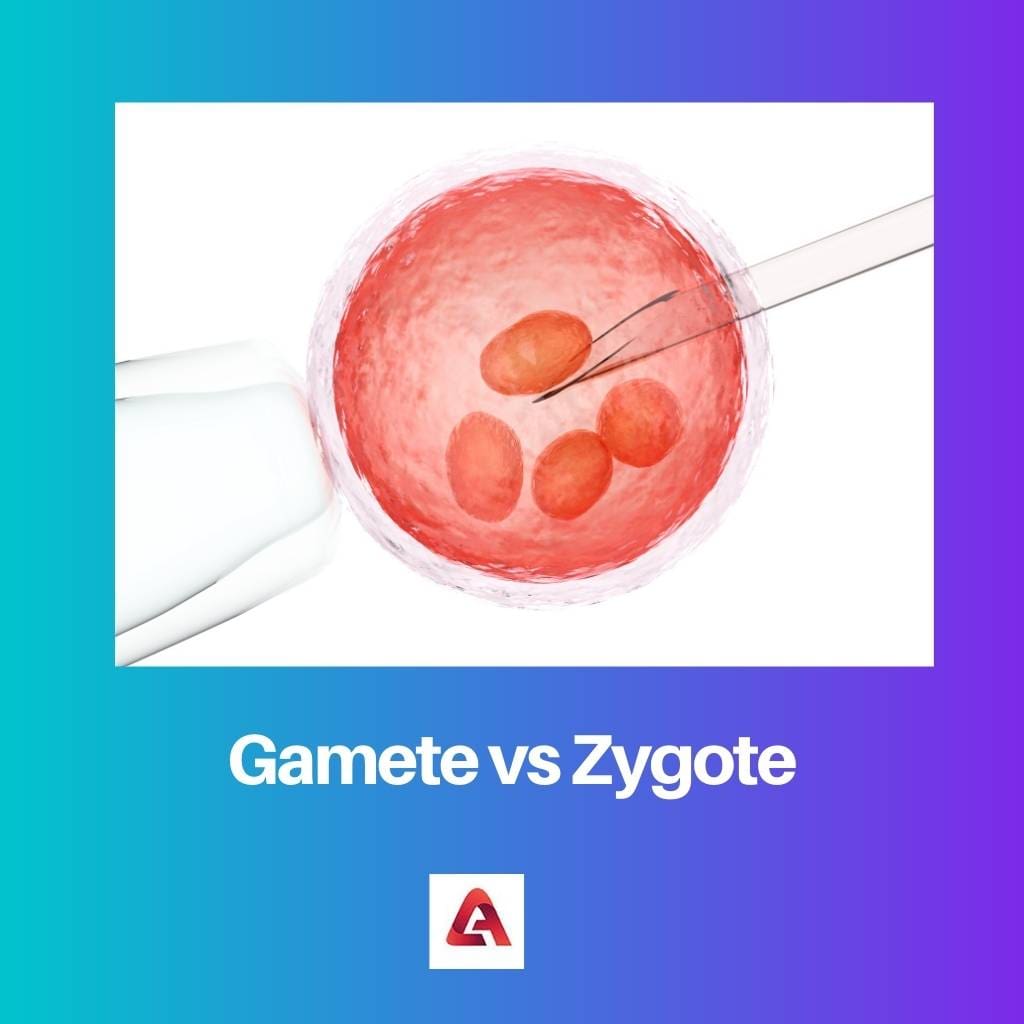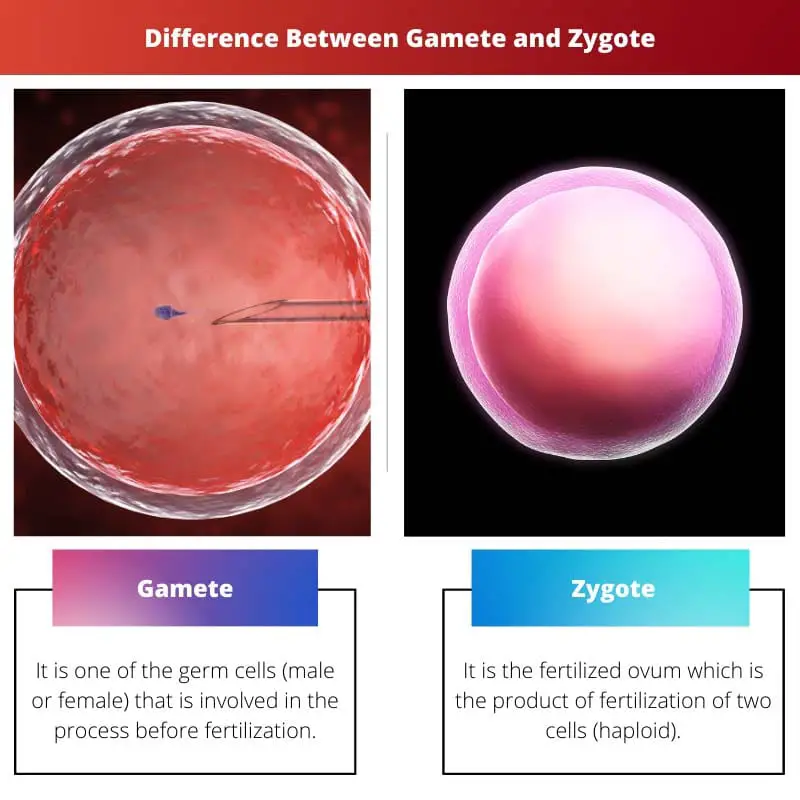Development is a complicated process that progresses in the form of a series of essential steps. At each step, a lot of structural and functional changes take place to maintain the required status of the fetus at the right time.
Gametes and zygotes are formed during the initial stages and play an important role in the determination of the final sex of the ovum. The chronology remains the same – zygote after fusion of the two gametes (X or Y).
Key Takeaways
- A gamete is a reproductive cell, such as a sperm or an egg, while a zygote is a fertilized cell that results from the fusion of a sperm and an egg.
- Gametes are haploid, meaning they have only one set of chromosomes, while zygotes are diploid, meaning they have two sets of chromosomes.
- Gametes are produced through meiosis, while zygotes are produced through fertilization.
Gamete vs Zygote
A gamete is a specialized sex cell produced by organisms with sexual reproduction, such as humans. In humans, the male produces sperm, which is the male gamete. A zygote is a cell that is formed when a sperm fertilizes an egg. It is the first cell that forms after fertilization occurs. The zygote contains all the genetic information necessary to create a new organism.

A gamete is divided into two sub-categories which include egg (female gamete) and sperm (male gamete). They are partially distinguished from each other.
Unless and until fusion takes place, the gametes cannot express themselves in their actual state and remain non-functional.
A zygote is a spherical mass formed as a result of fusion. It is the first stationary phase and marks the onset of attachment of the resultant mass inside the womb.
Other developmental stages follow suit. In other words, two haploid cells combine to form a diploid cell.
Comparison Table
| Parameters of Comparison | Gamete | Zygote |
|---|---|---|
| Definition | It is one of the germ cells (male or female) that is involved in the process before fertilization. | It is the fertilized ovum which is the product of fertilization of two cells (haploid). |
| Final Product Produced | Zygote. | Fetus. |
| Movement | The male cell is capable of movement, the female cell is not. | No movement is possible. |
| Cell Composition | Single chromosome and single autosome copy. | Either pair of chromosomes and double autosome copy. |
| Types | Male gamete and female gamete. | The final zygote is an exclusive type in itself. |
What is Gamete?
A gamete is a simple sex cell. It regulates the expression of male or female characters in the fused mass.
Therefore, the resultant sex is determined by the original gametes which participate in the fusion. While some researchers leave it to chance, others have established that the fusion of two X chromosomes is more likely than the fusion of an X chromosome with a Y chromosome.
A gamete is just a mode of combination post-copulation.
This is because X (female) is always fixed. The determination is completely based on which of the sperm (X type or Y type) will fuse with the egg. Though the probability is considered to be fifty percent due to the equal composition, it might not apply in all cases.
As far as the location is concerned, the female gamete is located in the female reproductive system (ovaries), and the male gamete is in the male reproductive system (testicles).
A male gamete cannot fuse with a male gamete, while a female gamete can. This means that an X chromosome is allowed to fuse with either the X or Y chromosome. On the other hand, a Y chromosome can only unite with the X chromosome and not the Y chromosome.
The former case leads to a resultant female, while the latter is the composition of a male.

What is Zygote?
A zygote is a fertilized unit that attaches to the fallopian tube after fusion and goes through a series of developments to ultimately become the fetus. It can also be referred to as the first stage, when the fetus gets its original identity.
The etymology is as follows – zygote has been derived from the Greek word “yoked,” which means “to join.” In this process, the male gamete is joined with the female gamete, resulting in the subsequent fusion of the two.
The total number of chromosomes that constitute a chromosome is 46 – 23 from the male gamete and 23 from the female gamete, respectively. As far as the size is concerned, a zygote is bigger than the gametes which participated in its formation.
The shape turns spherical in some days and ultimately takes the shape of a developed embryo. The movement is restricted due to the process of permanent implantation in the fallopian tube.
It also determines the success rate of the fertilization that took place in the earlier stage. Unless the zygote attaches itself to the fallopian tube, the implantation process cannot progress.
Consecutively, the growth of the embryo is also barred. The resultant fetus may or may not survive due to the uncertainty of survival conditions in such a fatal scenario.

Main Differences Between Gamete And Zygote
- A gamete is defined as a sex cell (either male or female) which is the beginning unit of fertilization. On the other hand, a zygote is the combined result of fertilization which has a separate identity of its own.
- The resultant unit of the fusion of gametes is the zygote itself, while the zygote does not undergo any further fusion but develops into a fetus as time progresses.
- As far as motility is concerned, the gamete can move in a limited manner (only male), while the zygote is a fixed entity incapable of any kind of movement.
- A gamete is made up of one type of chromosome (either X or Y) and includes an autosome copy. On the contrary, a zygote always consists of a pair (similar or different), and two copies of autosomes are included.
- The two exclusive types of gametes are – male (Y chromosome) and female (X chromosome). Since a zygote is diploid in nature, it is not further subcategorized into any other types.

- https://link.springer.com/article/10.1007/BF01134577
- https://www.tandfonline.com/doi/abs/10.1080/00071619200650241

The distinction between gametes and zygotes is highlighted well in this article, providing a clear understanding of their differences in terms of movement and composition. It’s essential to grasp these concepts for a comprehensive comprehension of development.
I couldn’t agree more. The details presented here are valuable in gaining insights into the biology of reproduction and embryonic development.
Absolutely, understanding the characteristics and functions of gametes and zygotes is fundamental in developmental biology.
The detailed explanations and contrast between gametes and zygotes are highly informative and valuable. Understanding the specifications of these reproductive cells is essential in comprehending the process of development.
The comprehensive breakdown of the characteristics and functions of gametes and zygotes provides a profound insight into the biological mechanisms governing fetal development.
Absolutely, the elucidation of the distinctions between gametes and zygotes enhances our understanding of the intricate processes involved in human development.
The detailed explanation of gametes and the zygote as the initial phase of attachment inside the womb is enlightening. It deepens our knowledge of the complex processes underlying embryonic development.
I couldn’t agree more. The elucidation of these crucial biological concepts is truly fascinating and intellectually stimulating.
The description of gametes and zygotes is thorough and enlightening. It emphasizes their critical roles in the development of a new organism, from the initial fusion to the formation of the zygote and beyond.
I completely agree. This article provides a comprehensive understanding of the significance of gametes and zygotes in the developmental process.
The detailed comparison between gametes and zygotes provides a comprehensive understanding of the development process. It’s intriguing to delve into the biological intricacies of reproduction and embryology.
It is interesting to know that gametes are haploid cells with only one set of chromosomes, while zygotes are diploid cells with two sets of chromosomes. This difference is crucial in understanding their functions and roles in the process of development.
I agree. The contrast between gametes and zygotes is fascinating and plays a significant part in the entire development process.
The detailed explanation of gametes being specialized sex cells and the zygote as the first stage of an organism’s identity is illuminating. It enriches our knowledge of reproductive biology and embryonic development.
Indeed, the insights provided here enhance our understanding of the intricate processes involved in the development of new life.
The comparison table is a great way to visually differentiate between gametes and zygotes. It succinctly summarizes the defining characteristics of each, making it easier to comprehend their roles in the process of development.
I found the comparison table to be quite informative and helpful. It provides a quick reference for understanding the key differences between gametes and zygotes.
The distinction between male and female gametes and their respective roles in determining offspring’s sex is intriguing. Also, the explanation of the zygote as the first stationary phase in development is thought-provoking.
The concept of the zygote as the onset of attachment of the resulting mass inside the womb is fascinating. The initial stages of development are truly captivating.
I found the differentiation between male and female gametes quite captivating. It’s essential knowledge in understanding reproductive biology.
The detailed explanations about gametes and zygotes shed light on their functions and importance in determining the sex of the offspring. It’s captivating to delve into the intricacies of reproductive biology.
Absolutely, the complexity of gametes and zygotes in the process of differentiation and fetal development is intriguing.